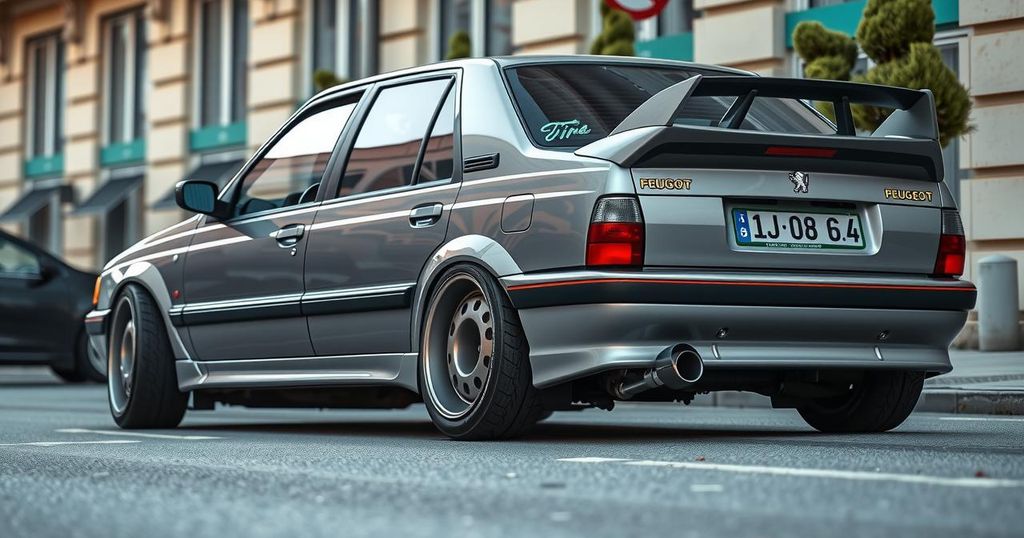The Curiously Elevated Tuner Culture of the Peugeot 405 in Iran

In Iran, the Peugeot 405 has become a central figure in local tuning culture, with enthusiasts embracing unique modifications like raised rear ends—originating from smuggling practices. The GLX model is particularly popular for its blend of style and engine capability. Shayan, a local tuner, shared insights into the cultural significance of the vehicle and the creative modifications that define this vibrant scene despite political and social barriers.
In the world of automotive culture, each nation has its own distinct flavors. From America’s muscle cars to Japan’s turbocharged wonders, every country has something unique. In Iran, however, a surprising trend has emerged around the Peugeot 405, and particularly its distinctive rear-end modification that elevates it towards the skies—an aesthetic relatively uncommon elsewhere.
Despite being a fixture in Iran for over three decades, the Peugeot 405 remains cherished. Production first started in France back in 1987, and an Iranian factory began operations in 1992. Fast forward to today, and the Peugeot 405 lives on—not as a replica, but as the Peugeot PARS, with some modern adaptations. Despite ending production last year due to competition from newer Chinese models, the car has carved out a significant niche in the Iranian automotive landscape.
With so many Peugeot 405s flooding the roads in Iran, they have become pivotal to the local car culture, especially among tuners and modders. Recently, I spoke to Shayan, a local enthusiast who shed light on the ongoing love affair with the vehicle. “We in Iran really like the Peugeot 405,” he emphasized, noting its enduring popularity among both young and middle-aged individuals. Shayan even shared images and videos showcasing the vibrant car scene in his country.
Within the 405 lineup, the GLX variant is particularly coveted for its aesthetic appeal and mechanical potential. Shayan described it beautifully, highlighting its production details and the stylish cream dashboard that came during certain production years. Enthusiasts flock to this version for more than just its looks; the engines it houses—the XU9 and XU7 L3—are prime candidates for modification. These engines are relatively modest, delivering about 100 horsepower, yet they form the backbone of a buzzing tuning community.
The tuning practices are diverse. From upgraded air intakes to exhaust systems, many enthusiasts focus on sound and responsiveness rather than raw power numbers. Notable examples include heavily modified cars running turbochargers and nitrous kits, with some pushing the limits up to 700 horsepower. However, the emphasis generally remains on performance rather than achieving outlandish specifications.
After discussing its specs, it becomes clear that the Peugeot 405’s tuning versatility keeps its enthusiasts engaged. For instance, the later Pars ELX with a 1.9-liter engine offers similar modification potential and is frequently showcased on social media platforms. Despite its original theoretical top speed of 118 mph, Shayan proudly claimed that some people have reached as high as 261 km/h (161 mph) in their tuned models.
The striking trend of raising the Peugeot’s rear is another intriguing aspect of Iran’s car culture. Shayan explained, “In Iran, we elevate the rear instead of lowering it, which has historical roots in smuggling.” The higher suspension is not just for aesthetics; it serves the practical purpose of preventing the car from scraping the ground under load, which is crucial for illicit activities. This trend, however, also caught the eye of local tuners looking for a unique style.
Interestingly, some people have started utilizing air suspension systems to alternate between this high stance and a more conventional drop. This approach allows for aesthetic flexibility. Shayan even mentioned inventive modifications, such as one owner outfitting their car with a mechanism to dispense caltrops in evasion scenarios.
At car meets across Iran, the enthusiasm for Peugeot 405s is palpable. The scene merges traditional modifications like other global car cultures, while capturing a distinctly Iranian flavor. The teal-blue trim, elevated rear design, and community-driven spirit are hallmarks of this automotive subculture. Shayan also showcased his own modified 405 GLX, noting the gorgeous silver color and internal tweaks that cater to both performance and style.
Despite political limitations hindering greater awareness, it is apparent that the Iranian automotive culture is vibrant and rich. While many may overlook it due to a language barrier or a lack of engaging media, the reality on the ground is anything but dull. The Peugeot 405, an enduring icon among car enthusiasts, serves as a reminder of the universal love for cars and the creativity of those who modify them — no matter where they are from.
The Iranian car scene, steeped in history and characterized by a passionate community, parallels others around the globe. It shows that wherever there are wheels—and people eager to elevate their automotive experience—there will always be tuners looking to push boundaries, creating an unexpected beauty in their craft.
The Peugeot 405 has firmly embedded itself within Iran’s automotive culture, showcasing the country’s unique tuning style. Enthusiasts favor the GLX variant for its modification potential and aesthetic appeal, evidenced by impressive speeds achieved through rigorous tuning. The distinctive rear-end lift, while rooted in practicality, has transformed into a stylistic choice within the local scene. Despite socio-political barriers limiting exposure, the vibrant Iranian car culture, characterized by creativity and community, shines through, illustrating a universal passion for cars that transcends borders.
Original Source: www.theautopian.com




